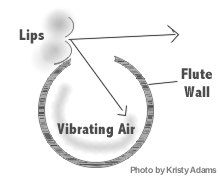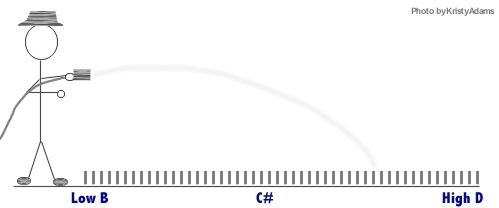Masterclass
Notes
Here
are some notes that I have collected from various masterclasses with Dr.Trygve
Peterson (Julliard Doctorate), Mr. Eric Hoover (current Vice President
of the National Flute Association), Amy Porter (Former Principle of the
Atlanta Symphony Orchestra), and Paula Robinson,Jean Pierre Rampal, and
Bonita Boyd (flute teacher at Eastman School of Music). I have organized
these into topics since there is so much information. I have to admit,
that I did not write down who talked about what, but I will credit some
of the information the best of my ability. |

Warming
Up
Harmonics
Breathing
Embrochure
Refinement
Exercises
Common
Myths
Thoughts
on Exercising
12
Dirty Secrets to a Successful Musician
|
Home
| About | Careers
| History | Makers
| Masterclass | Links
| Contact
Warming
Up
Start
off the day by playing Taffenal EJ 1 and then move to EJ 4. The first
and third beats outline a major scale in a major pattern and harmonic minor
in a minor pattern.
Think
of the minor pattern in melodic minor with these exceptions:
-
First
and last descending patterns before the modulation are harmonic.
-
Alterations
exist between the sixth and seventh degrees of the harmonic minor outline
because of the voice leading.
-
The last
pattern modulates into the next key by the addition of a flat of subtraction
of a sharp.
Do the
De
La Sonorite
matching tones and constant tones. |
|
|
Harmonics
Play a
middle C on the flute and then with the same fingering, over blow up to
two octaves, taking one partial at a time until the second octave C is
reached. In that harmonic range, play a simple pattern like C-D-E-F-G-F-E-D-C
about four times. Make sure that your tone is the best possible while
doing this.
Another
exercise for harmonics is to finger and play middle C then over blow to
the second octave C as like above. While in that octave, switch fingerings
to the same pitch of that note. Otherwise, play the real fingering
of the third octave C. |
|
|
Breathing
Inhale
breaths in short amounts until the lungs and diaphragm are completely filled.
Hold it until you can not hold it no more and then slowly exhale.
Do this before you even blow into the flute.
Sit
down on the floor and put your legs straight out in front of you.
Lean back at a 45 degree angle with shoulders as straight as possible.
Play scales and patterns (pref. Taffenal). Feel the pressure in the middle
of the stomach, not the lower part. Learn to play with that kind
of feeling in your stomach like when you sat back.
Another
exercise is standing up and bend forward at the waist to make your back
parallel to the floor. Play your scales and exercises. Feel
the support.
Get
on your hands and knees and keep your back parallel to the ceiling and
floor. Play the flute in that position best as possible. |
|
|
Embrouchure
The air
hole should be round, not oval. Another acceptable shape you could
do would be in the shape of a test tube in an upright position.
For
balance of the flute and to get the correct pressure on the keys, learn
to play without the right thumb that is used to balance the flute.
Also, do this if you suffer from tendentious or carpal tunnel. It
keeps all the pressure from being applied to one area of the hand that
causes these.
To
have a well balanced sound, have plenty of space to move and play.
Play bent forward at the waist, and play bending in different directions
from left to middle, from middle to right, and so forth.
This
is very important!! When putting the flute together, NEVER
hold the head joint on the embrouchure plate or the keys! Your embroshure
plate may come off and there is nothing like having to find a welder before
that big audition.
When
auditioning, the judges prefer to hear music cleanly, even if it means
playing it slowly. The better playing is clean!
 |
For
higher pitches, air is vibrated at half its rate.
When
playing higher pitches, the angle of air blown into the flute MUST NOT
CHANGE!! Aim for the edge of the wall to split the air stream. Pinch
the lips for the higher pitches. For lower pitches, focus the airstream
lower into the flute wall.
Do
not
crack or squeek the notes. |
The Garden
Hose Analogy

|
| Volume
is how loud or soft sound is. Fred the farmer shows us that when
he squirts his hose in his garden at full blast without his finger over
the nozzle, it does not reach very far, but when he puts his finger over
the nozzle, more pressure is built up and the water squirts out farther
because of the smaller hole. |
|
|
|
Refinement
Exercises
Changing
Dynamic Long tones is used to clean up the sound and help control the pitch
(tapers). With long notes do:
-
ff
to pp
-
ppp
to ff
-
p
to ff to p
-
ff
to p to ff
Use
a tuner at all times!!!
Compound
Tonguing Exercises:
-
Singing
T-K or D-G
-
Scales
4, 2, and 1 note per degree for double tongue.
-
Overlap
of compound with single (ex. Single mm=120, Double mm=100)
Scales
6, 3, and 1 per note degree for triple tongue. Types for this include:
1.) DGD DGD 2.) DGD GDG 3.) DDG DDG Keep notes long when going fast.
No space should be between them.
|
|
|
Common
Myths
Myth #1: When we inhale,
we inhale air through the nose, into the lungs, and finally, the diaphragm.
The correct
answer is that when we inhale, the inner coastal abdominal muscles control
the input and output of air. Support is PULLING in muscles.
Myth #2: The flute makes
a sound by the air vibrating across the embouchure hole and swirls around
inside causing vibrations.
The correct
answer is that the air reed is what vibrates. When we blow into the flute,
the air splits in half. All of the air is not directly blown into the flute. |
|
|
Thoughts
on Practicing
Axiom
1: Practicing is always effective.
Axiom
2: Practicing is the repetition of accuracy.
The
best ways to practice are as follows:
I. Small
Sections:
-
Practice
short sections at a time (two bars and one note or four bars and one note).
The section must end with a strong beat.
-
There
is a tempo at which you can do the passage perfectly. Use that tempo. Speed
will gradually increase.
-
Observe
dynamics from the very first playing.
-
Apply
your analytical techniques (e.g. recognize scales and arpeggios), and memorize
immediately.
II.
"I believe
in marking off all passages which we find especially difficult, and then
practicing those passages patiently. Concentratedly, intelligently,
relentlessly. . .until we have battered them down, knocked them out, surmounted
them, dominated them, conquered them. . .until we have transferred them
permanently from the weakest into the strongest passages of the piece."
-- Charles
Cook, Playing the Piano for Pleasure
"Play
accurately; avoid reading errors, otherwise it becomes necessary to tear
up the old track and lay the new, which is a tough task indeed. Practice
those fractures until they no longer exist."
-- IBID
"Slowness
gives the feel, rapidity the gesture."
-- Ernst
Bacon, Notes on the Piano
III. Mental
Practice:
"Think
ten times and practice once."
--
Paul Pollei,
Pedagogical Tips for Piano Teaching
"The
mind knows no technical problems. One must first hear the sound, then practice."
--
Rosina Lhevinne,
How to Teach Piano Successfully
"One
must practice with full attention to all the details, so that all of those
processes which are below the level of awareness in performance may function
reliably. If that confidence is wanting, anxiety cannot be far behind.
A successful performance depends on the extent to which one can transcend
being overly conscious of details, difficulties etc., and reach that state
in which the feelings and emotions of the music almost fully occupy one's
consciousness."
--
Dale Reubart
|
|
|
12
Dirty Secrets to be a Successful Musician
(or what
they don't tell you at Julliard)
By
Dr. Trygve Peterson
Flute
Professor at Arizonia State University
-
1.
"Nothing ventured, nothing gained." If you do not want to go
to a school far away from home to learn from the best, then there may be
a chance that you may not be successful. To become the best, studies must
be done with the best.
-
2.
"Be your own best teacher."
Never look to the private instructor about
problems constantly. Instructors teach the students only 5% of the time
of our musical development. Be skeptical about what is learned and ask
yourself what and how does this apply to yourself.
-
3. "Okay,
so the New York Philharmonic won't take me. . ." So there are about
100 orchestras in the United States. There are only four flute positions
open per each one. You must be flexible with the music career willing to
do anything. Some suggestions are starting your own studio, school, chamber
groups, musical organizations, flute choirs, teacher, etc.
-
4. "That's
a good player, but. . ." The best player does not always get the job
or succeeds. Personal integrity is very important to succession. Be able
to get along with anyone. You need people to help support you and you need
more friends than enemies.
-
5. "Compete,
and you lose."
Do not be competitive with your peers. This is a BIG
MISTAKE! Making more enemies is the only outcome of competing with peers.
-
6. "Music
is a business, know your customer." Music is not only an art, but an
business. Money, income, supply, and demand is also part of the music world.
To get business, advertise at schools, yellow pages, etc. Market and merchandising
your product is very important. Learn to write a contract in order to keep
from getting burned in the future.
-
7. "No
excuses."
Even if you try hard, the world revolves around results,
not attempts. Produce the stuff and be ready, no excuses whatsoever. Be
very responsible!
-
8. "Grow
a very thick hide. (What doesn't kill you makes you stronger.)" Music
is a hard business. You can't let anyone put you down by criticism or rude
remarks and behavior.
-
9. "Attitude
is almost everything."
Confidence, cooperativeness, resilience, tolerance,
flexibility, optimism, and respect is part of having a good attitude. Matureness
is very important. A good attitude is very realistic. Do not over exaggerate
anything. Professional is being a mature adult.
-
10. "Life
is never fair, so get over it. . ." Fairness is not realistic. There
is no such thing. Do not make yourself the victim.
-
11. "Get
a life!"
Think about what hobbies and interests you have that does
not have anything to do with music. No one wants a music only freak. Develop
hobbies to keep healthy mentally, and physically. Music reflects healthiness.
Do no be stupid and tell committees about your personal life. Be balanced.
12.
"If
you want to succeed, patience and discipline are important." Discipline
means year after year of doing tonal studies, keeping fundamentals, etc.
Music is a physical activity. Less than 1% is performance and the rest
is practice. Patience is accepting the fact that getting a job may take
a long time. Start at the bottom and work up.
|
|
|
|